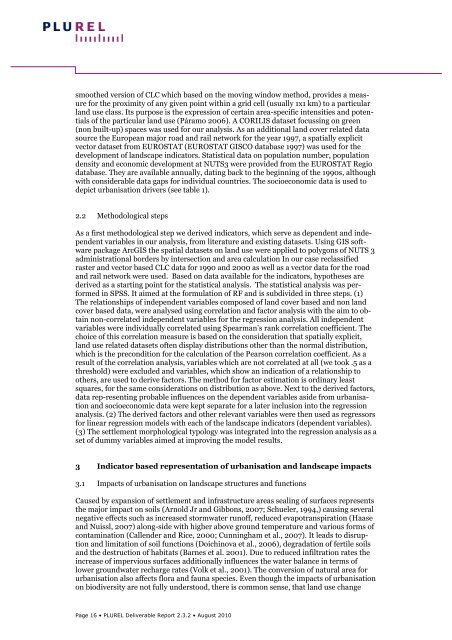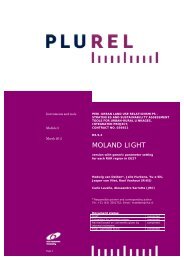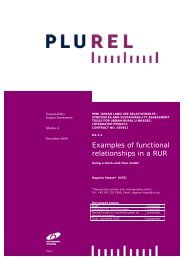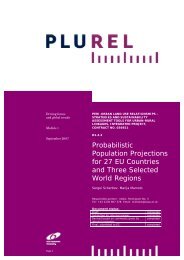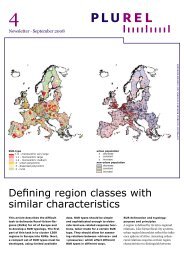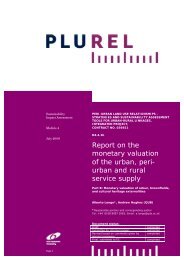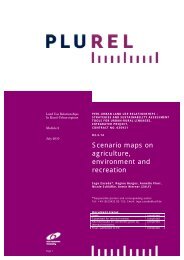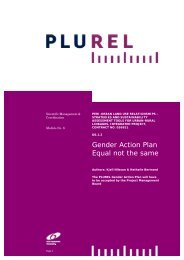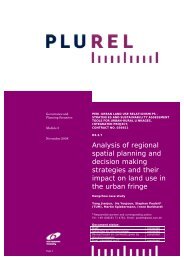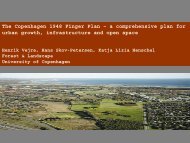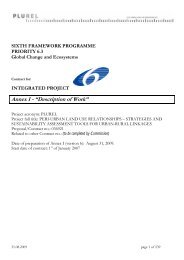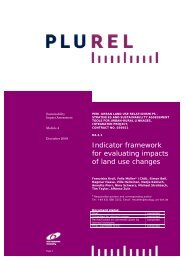Delination of response Functions - Plurel
Delination of response Functions - Plurel
Delination of response Functions - Plurel
- No tags were found...
Create successful ePaper yourself
Turn your PDF publications into a flip-book with our unique Google optimized e-Paper software.
smoothed version <strong>of</strong> CLC which based on the moving window method, provides a measure<br />
for the proximity <strong>of</strong> any given point within a grid cell (usually 1x1 km) to a particular<br />
land use class. Its purpose is the expression <strong>of</strong> certain area-specific intensities and potentials<br />
<strong>of</strong> the particular land use (Páramo 2006). A CORILIS dataset focussing on green<br />
(non built-up) spaces was used for our analysis. As an additional land cover related data<br />
source the European major road and rail network for the year 1997, a spatially explicit<br />
vector dataset from EUROSTAT (EUROSTAT GISCO database 1997) was used for the<br />
development <strong>of</strong> landscape indicators. Statistical data on population number, population<br />
density and economic development at NUTS3 were provided from the EUROSTAT Regio<br />
database. They are available annually, dating back to the beginning <strong>of</strong> the 1990s, although<br />
with considerable data gaps for individual countries. The socioeconomic data is used to<br />
depict urbanisation drivers (see table 1).<br />
2.2 Methodological steps<br />
As a first methodological step we derived indicators, which serve as dependent and independent<br />
variables in our analysis, from literature and existing datasets. Using GIS s<strong>of</strong>tware<br />
package ArcGIS the spatial datasets on land use were applied to polygons <strong>of</strong> NUTS 3<br />
administrational borders by intersection and area calculation In our case reclassified<br />
raster and vector based CLC data for 1990 and 2000 as well as a vector data for the road<br />
and rail network were used. Based on data available for the indicators, hypotheses are<br />
derived as a starting point for the statistical analysis. The statistical analysis was performed<br />
in SPSS. It aimed at the formulation <strong>of</strong> RF and is subdivided in three steps. (1)<br />
The relationships <strong>of</strong> independent variables composed <strong>of</strong> land cover based and non land<br />
cover based data, were analysed using correlation and factor analysis with the aim to obtain<br />
non-correlated independent variables for the regression analysis. All independent<br />
variables were individually correlated using Spearman’s rank correlation coefficient. The<br />
choice <strong>of</strong> this correlation measure is based on the consideration that spatially explicit,<br />
land use related datasets <strong>of</strong>ten display distributions other than the normal distribution,<br />
which is the precondition for the calculation <strong>of</strong> the Pearson correlation coefficient. As a<br />
result <strong>of</strong> the correlation analysis, variables which are not correlated at all (we took .5 as a<br />
threshold) were excluded and variables, which show an indication <strong>of</strong> a relationship to<br />
others, are used to derive factors. The method for factor estimation is ordinary least<br />
squares, for the same considerations on distribution as above. Next to the derived factors,<br />
data rep-resenting probable influences on the dependent variables aside from urbanisation<br />
and socioeconomic data were kept separate for a later inclusion into the regression<br />
analysis. (2) The derived factors and other relevant variables were then used as regressors<br />
for linear regression models with each <strong>of</strong> the landscape indicators (dependent variables).<br />
(3) The settlement morphological typology was integrated into the regression analysis as a<br />
set <strong>of</strong> dummy variables aimed at improving the model results.<br />
3 Indicator based representation <strong>of</strong> urbanisation and landscape impacts<br />
3.1 Impacts <strong>of</strong> urbanisation on landscape structures and functions<br />
Caused by expansion <strong>of</strong> settlement and infrastructure areas sealing <strong>of</strong> surfaces represents<br />
the major impact on soils (Arnold Jr and Gibbons, 2007; Schueler, 1994,) causing several<br />
negative effects such as increased stormwater run<strong>of</strong>f, reduced evapotranspiration (Haase<br />
and Nuissl, 2007) along-side with higher above ground temperature and various forms <strong>of</strong><br />
contamination (Callender and Rice, 2000; Cunningham et al., 2007). It leads to disruption<br />
and limitation <strong>of</strong> soil functions (Doichinova et al., 2006), degradation <strong>of</strong> fertile soils<br />
and the destruction <strong>of</strong> habitats (Barnes et al. 2001). Due to reduced infiltration rates the<br />
increase <strong>of</strong> impervious surfaces additionally influences the water balance in terms <strong>of</strong><br />
lower groundwater recharge rates (Volk et al., 2001). The conversion <strong>of</strong> natural area for<br />
urbanisation also affects flora and fauna species. Even though the impacts <strong>of</strong> urbanisation<br />
on biodiversity are not fully understood, there is common sense, that land use change<br />
Page 16 • PLUREL Deliverable Report 2.3.2 • August 2010


